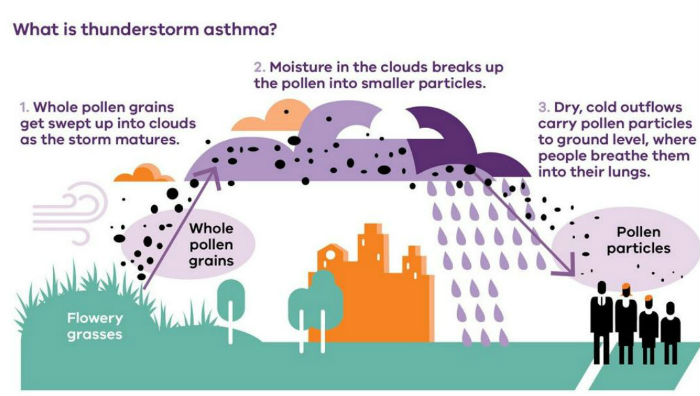
Epidemic thunderstorm asthma is the phenomenon where a large number of people develop asthma symptoms over a short period of time. It is thought to be triggered by an uncommon combination of high pollen levels and a certain type of thunderstorm.
This occurs when pollen grains from grasses get swept up in the wind and carried for long distances. Just before the storm, some burst open and release tiny particles that are concentrated in the wind, and get blown down to the ground, where people can breathe them in. They are small enough to go deep into the lungs and can trigger asthma.
These thunderstorm asthma events don’t occur every year but when they do, they can happen during the grass pollen season in south-east Australia. This is typically from October through December.
Who is at risk of thunderstorm asthma?
Those at increased risk of epidemic thunderstorm asthma include:
- People with asthma
- People with a past history of asthma
- Those with undiagnosed asthma
- People with seasonal hay fever who are allergic to grass pollens who have not ever had asthma
Having both hay fever and asthma that is poorly controlled increases the risk further.
What can you do to help?
- Know the symptoms of hay fever and asthma
- Please make sure that you let us know if your child suffers from asthma or hay fever.
- Have the right plan and medications in place.
- If your child has a preventer medication for their asthma this is a key to keeping well. This will work to reduce the inflammation in the airways making them less sensitive, which decreases the frequency and severity of asthma symptoms (reducing the need for your reliever medication)
If you are struggling to control your child’s asthma symptoms please get a medical review. If you have experienced any of the following in the last four weeks, it indicates your child’s asthma may not be under control.
- daytime asthma symptoms more than 2 days per week
- need for reliever more than 2 days per week
- any limitation on activities due to asthma symptoms
- any asthma symptoms during the night or on waking
What will the school do to minimise the risk?
Toorak Primary School will monitor when the risk of epidemic thunderstorm asthma is high. If there is extreme risk, susceptible students will be kept inside.
Website for monitoring pollen count: //www.pollenforcast.com.au/
